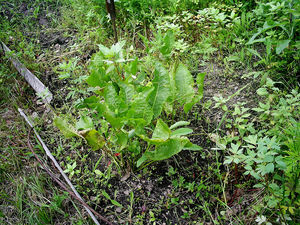Horseradish (Armoracia rusticana) is native to eastern Europe. Horseradish has been cultivated for at least 2000 years, and was mentioned and illustrated by classical herbalists such as Dioscorides. The species is seed sterile and propagated by cuttings. The pungent smell is due to the presence of glucoside sinigrin (2-propenyl glucosinolate). The plant also has a high vitamin C content. The root has a strong eye-watering pungency and a powerful and stimulating flavor. It is a perennial, dark green plant with whiteflowers. The young leaves can be used for flavoring, but it is the root that most people associate with horseradish. The root has to be dug up fresh because it does not store or keep well.
Medicinal Properties
•Horseradish is a diuretic, which increases urinary flow. It increases perspiration as well, which can be good for some fevers, and it can be made into a poultice to be used externally for wound infections, arthritis and pleurisy. Taken internally, it can relieve gout and arthritis as well as urinary and respiratory infections.
•Horseradish root is also good for hoarseness. Infuse one tablespoon of vinegar, two tablespoons of grated horseradish, and one-third cup water for one hour. Pour off the settled horseradish. Add two-thirds cup of honey to the liquid and take one tablespoonful every hour until hoarseness is gone. A syrup can be made by boiling scraped horseradish in brown sugar. This an excellent remedy to promote expectoration, and remove hoarseness.
•For a sore throat, mix 1 tablespoon of grated fresh horseradish with 1 teaspoon of honey, and 1 teaspoon of ground cloves in a glass of warm water. Stir and sip slowly, or use as a gargle.
•Half a teaspoon of grated horseradish, flavored with lemon juice, can be taken twice a day for sinus conditions.
•For rheumatism, take 3-4 tablespoons of horseradish daily with apple cider vinegar and honey.
•For colitis, take 15-20 drops of horseradish juice between meals.
•Grated horseradish root topically decreases the irritation of injuries and bruises.
•For allergies, take a spoonful of horseradish.
•The leaf of horseradish also has medicinal uses. A bruised leaf laid across the back of the neck is a cure for headaches. If you have facial neuralgia, some horseradish held in the hand on the affected side may provide relief.
You may want to use prepared horseradish when adding it to your food. It is often colored red with beet juice, but you can also find natural beige-colored horseradish. The fresh root should be grated carefully to prevent any juice from getting into the eyes. Then add it to cream and vinegar to make a sauce that can be used to add zest vegetables and meats. It makes a good accompaniment to hard-boiled eggs and smoked mackerel. You can make the root a little milder by adding apple to it when you are grating it. You can warm the sauce, but do so very gently because too much heat destroys the oils that give it its pungency.
Be cautious when using horseradish. The warming effect of horseradish can cause skin irritation in certain circumstances, and if too much is taken internally, it can cause vomiting and may provoke allergic reactions. It should not be given to anyone with stomach ulcers. Horseradish may be a strong diuretic, meaning that it may promote the production of urine by the body. Increased urine output may worsen kidney conditions, so individuals who have kidney diseases should not use large amounts of horseradish in their diets or take horseradish supplements. Chemicals in horseradish may also irritate the gastrointestinal tract. Therefore, taking it may worsen esophageal irritation or stomach conditions such as ulcers, so individuals with gastrointestinal conditions should avoid taking it. Because they may be more irritating for small children than for adults, horseradish supplements should not be given to children less than 4 years old.
RECIPES
Barbecue Sauce
1/2 cup butter
2/3 cup vinegar
1/3 cup hot water
1/2 cup tomato catsup
1 tbs. horseradish
Hot sauce to taste
Mix well, keep warm, and use to baste meat during the final stages of its cooking.
Crab Dip
This is great on French bread, cut lengthwise, with tomato slices and lettuce.
¾ cup nonfat sour cream
¼ cup nonfat mayonnaise
1 teaspoon prepared horseradish
¼ teaspoon dry mustard
½ teaspoon low-sodium soy sauce
Dash hot sauce
Pinch of cayenne
¼ pound crabmeat
Combine the sour cream and mayonnaise in a medium bowl and mix well. Add the horseradish, dry mustard, soy sauce, hot sauce, and cayenne and mix well again. Add crabmeat and stir to combine.
Chill for 2 hours to let the flavors blend.
Carrots with Creamy Horseradish Sauce
4 small carrots, sliced
1/3 cup nonfat sour cream
1 teaspoon minced shallots
1 teaspoon horseradish
1 teaspoon snipped fresh dill
Place a vegetable steamer in a medium-size saucepan and add water to the bottom of the basket. Steam the carrots for about 5 minutes, or until they’re tender when pierced with a fork. (Steaming time will vary considerably depending on how old the carrots are and how thickly you slice them.)
In a small mixing bowl, combine the sour cream, shallots, horseradish, dill, and salt.
When the carrots are cooked, place them in a serving bowl and pour the sauce over them. Serve immediately.
Horseradish Sauce
1/2 cup light sour cream
1/4 cup plain nonfat yogurt
2 tablespoons mayonnaise
2 tablespoons horseradish
Combine all ingredients and mix well.
Cucumber Raita
4 cucumbers, peeled and grated
1 teaspoon ground cumin
1 tablespoon cider vinegar
1 teaspoon horseradish
1-1/2 cups plain nonfat yogurt
Let the grated cucumber sit in a medium-size bowl in the refrigerator for about 30 minutes. Drain off any water that collects in the bowl and add the cumin, vinegar horseradish, and yogurt; stir well. Serve cold.
Chicken Breasts with Horseradish
4 tablespoons horseradish
4 tablespoons sour cream
1 tablespoon Dijon mustard
1 tablespoon white vinegar 4 6- to 8-ounce bone-in skinless chicken
breasts
Preheat oven to 350°. In a small mixing bowl, combine the horseradish, sour cream, mustard, and vinegar.
Arrange the chicken breasts in a baking pan. Sprinkle with salt and pepper. Spread each breast with the horseradish mixture.
Bake for 45 minutes until the topping is brown and the chicken juices run clear.
ALWAYS CONSULT A PHYSICIAN BEFORE TAKING ANY REMEDIES
References:
Bown. D. Encyclopaedia of Herbs and their Uses. Dorling Kindersley, London. 1995.
Facciola. S. Cornucopia – A Source Book of Edible Plants. Kampong Publications, 1990.
Foster. S. & Duke. J. A. A Field Guide to Medicinal Plants. Eastern and Central N. America. Houghton Mifflin Co. 1990
Peirce A. The American Pharmaceutical Association Practical Guide to Natural Medicines. New York: Stonesong Press, 1999.
Reference:
- Horseradish Information Council www.horseradish.org/ , Horseradish: A Root with Roots www.horseradish.org/history.html ,Horseradish – Wikipedia, the free encyclopedia www.en.wikipedia.org/wiki Horseradish Horseradish Recipes homecooking.about.com/library/archive/blhorseradish.htm




